Functionalization of the Surface of Porous Nickel–Titanium Alloy with Macrocyclic Compounds
Abstract
1. Introduction
2. Materials and Methods
2.1. Preparation and Functionalization of the Surface of Porous TiNi
2.2. Surface Characterization Methods
3. Results and Discussion
3.1. SEM Study
3.2. Thermogravimetric (TG) and Derivative Thermogravimetric (DTG) Curves
3.3. In Vitro Test
4. Conclusions
Author Contributions
Funding
Institutional Review Board Statement
Informed Consent Statement
Data Availability Statement
Acknowledgments
Conflicts of Interest
References
- Yasenchuk, Y.; Marchenko, E.; Gunther, V.; Radkevich, A.; Kokorev, O.; Gunther, S.; Baigonakova, G.; Hodorenko, V.; Chekalkin, T.; Kang, J.; et al. Biocompatibility and clinical application of porous tini alloys made by self-propagating high-temperature synthesis (SHS). Materials 2019, 12, 2405. [Google Scholar] [CrossRef] [PubMed]
- Zhang, L.; Zhang, Y.Q.; Jiang, Y.H.; Zhou, R. Superelastic behaviors of biomedical porous NiTi alloy with high porosity and large pore size prepared by spark plasma sintering. J. Alloys Compd. 2015, 44, 513–522. [Google Scholar] [CrossRef]
- Marchenko, E.S.; Baigonakova, G.A.; Yasenchuk, Y.F.; Chekalkin, T.L.; Volinsky, A.A. Structure, biocompatibility and corrosion resistance of the ceramic-metal surface of porous nitinol. Ceram. Int. 2022, 48, 33514–33523. [Google Scholar] [CrossRef]
- Popescu, I.N.; Vidu, R.; Bratu, V. Porous metallic biomaterials processing (review) Part 1: Compaction, sintering behavior, properties and medical applications. Sci. Bull. Valahia Univ. Mater. Mech. 2017, 15, 28–40. [Google Scholar] [CrossRef]
- Povimonsky, G.A.; Rapaport, H. Peptide coating applied on the spot improves osseointegration of titanium implants. J. Mater. Chem. B 2017, 5, 2096–2105. [Google Scholar] [CrossRef]
- Müller, R.; Abke, J.; Schnell, E.; Scharnweber, D.; Kujat, R.; Englert, C.; Taheri, D.; Nerlich, M.; Angele, P. Influence of surface pretreatment of titanium- and cobalt-based biomaterials on covalent immobilization of fibrillar collagen. Biomaterials 2006, 27, 4059–4068. [Google Scholar] [CrossRef]
- Sargeant, T.D.; Rao, M.S.; Koh, C.-Y.; Stupp, S.I. Covalent functionalization of NiTi surfaces with bioactive peptide amphiphile nanofibers. Biomaterials 2008, 29, 1085–1098. [Google Scholar] [CrossRef]
- Michiardi, A.; Hélary, G.; Nguyen, P.-C.T.; Gamble, L.J.; Anagnostou, F.; Castner, D.G.; Migonney, V. Bioactive polymer grafting onto titanium alloy surfaces. Acta Biomater. 2010, 6, 667–675. [Google Scholar] [CrossRef]
- Chen, W.C.; Ko, C.L. Roughened titanium surfaces with silane and further RGD peptide modification in vitro. Mater. Sci. Eng. C 2013, 33, 2713–2722. [Google Scholar] [CrossRef]
- Lutolf, M.; Hubbell, J. Synthetic biomaterials as instructive extracellular microenvironments for morphogenesis in tissue engineering. Nat. Biotechnol. 2005, 23, 47–55. [Google Scholar] [CrossRef]
- Kolesnichenko, I.V.; Eric, V. Practical applications of supramolecular chemistry. Anslyn. Chem. Soc. Rev. 2017, 46, 2385–2390. [Google Scholar] [CrossRef] [PubMed]
- Svenson, S.; Tomalia, D.A. Dendrimers in biomedical applications—Reflections on the field. Adv. Drug Deliv. Rev. 2005, 57, 2106–2129. [Google Scholar] [CrossRef] [PubMed]
- Sharma, A.; Sharma, U.S. Liposomes in drug delivery: Progress and limitations. Int. J. Pharm. 1997, 154, 123–140. [Google Scholar] [CrossRef]
- Husseini, G.A.; Pitt, W.G. Micelles and nanoparticles for ultrasonic drug and gene delivery. Adv. Drug. Deliv. Rev. Adv. 2008, 60, 1137–1152. [Google Scholar] [CrossRef] [PubMed]
- Lacerda, L.; Bianco, A.; Prato, M.; Kostarelos, K. Carbon nanotubes as nanomedicines: From toxicology to pharmacology. Adv. Drug Deliv. Rev. 2006, 58, 1460–1470. [Google Scholar] [CrossRef] [PubMed]
- Li, J.; Loh, X.J. Cyclodextrin-based supramolecular architectures: Syntheses, structures, and applications for drug and gene delivery. Adv. Drug Deliv. Rev. 2008, 60, 1000–1017. [Google Scholar] [CrossRef] [PubMed]
- Lin, R.; Cui, H. Supramolecular nanostructures as drug carriers. Curr. Opin. Chem. Eng. 2015, 7, 75–83. [Google Scholar] [CrossRef]
- Xin, J.; Lijuan, Z.; Bai, X.; Xinyuan, Z.; Deyue, Y. Supramolecular nanoscale drug-delivery system with ordered structure. Natl. Sci. Rev. 2019, 6, 1128–1137. [Google Scholar]
- Lizal, T.; Sindelar, V. Bambusuril anion receptors. J. Chem. 2018, 58, 326–333. [Google Scholar] [CrossRef]
- Biedermann, F.; Nau, W.M.; Schneider, H.J. The Hydrophobic Effect Revisited—Studies with Supramolecular Complexes Imply High-Energy Water as a Noncovalent Driving Force. Angew. Chem. Int. Ed. 2014, 53, 11158–11171. [Google Scholar] [CrossRef]
- Biedermann, F.; Schneider, H.J. Experimental Binding Energies in Supramolecular Complexes. Chem. Rev. 2016, 116, 5216–5300. [Google Scholar] [CrossRef] [PubMed]
- Sokolov, J.; Štefek, A.; Šindelář, V. Functionalized Chiral Bambusurils: Synthesis and Host-Guest Interactions with Chiral Carboxylates. Chem. Plus Chem. 2020, 85, 1307–1314. [Google Scholar] [CrossRef] [PubMed]
- Fiala, T.; Ludvíková, L.; Heger, D.; Švec, J.; Slanina, T.; Vetráková, L.; Sindelar, V. Bambusuril as a one-electron donor for photoinduced electron transfer to methyl viologen in mixed crystals. J. Am. Chem. Soc. 2017, 139, 2597–2603. [Google Scholar] [CrossRef] [PubMed]
- Valkenier, H.; Akrawi, O.; Jurček, P.; Sleziaková, K.; Lízal, T.; Bartik, K.; Šindelář, V. Fluorinated bambusurils as highly effective and selective transmembrane Cl−/HCO3− Antiporters. Chem 2019, 5, 429–444. [Google Scholar] [CrossRef]
- Sokolov, J.; Šindelář, V. Chiral Bambusurils for Enantioselective Recognition of Carboxylate Anion Guests. Chem. Eur. J. 2018, 24, 15482–15485. [Google Scholar] [CrossRef] [PubMed]
- Aktanova, A.; Abramova, T.; Pashkina, E.; Boeva, O.; Grishina, L.; Kovalenko, E. Assessment of the Biocompatibility of Cucurbiturils in Blood Cells. Nanomaterials 2021, 11, 1356. [Google Scholar] [CrossRef]
- Nagarajan, R.; Hyun, D.; Narayanan, S.; Go, Y.H.; Ko, Y.H.; Park, M.; Kim, K. Cucurbituril anchored silica gel. Tetrahedron Lett. 2006, 47, 2073–2075. [Google Scholar] [CrossRef]
- Wu, S.; Xu, J.; Zou, L.; Luo, S.; Yao, R.; Zheng, B.; Liang, G.; Wu, D.; Li, Y. Long-lasting renewable antibacterial porous polymeric coatings enable titanium biomaterials to prevent and treat peri-implant infection. Nat. Commun. 2021, 12, 1–14. [Google Scholar] [CrossRef]
- Svec, J.; Necas, M.; Sindelar, V. Bambus[6]uril. Angew. Chem. Int. Ed. 2010, 49, 2378–2381. [Google Scholar] [CrossRef]
- Kokorev, O.; Chekalkin, T.; Marchenko, E.; Yasenchuk, Y.; Gunther, S.; Serebrov, V.; Chernyshova, A.; Obrosov, A.; Uludintceva, E.; Kang, J. Exploring the role of surface modifications of TiNi-based alloys in evaluating in vitro cytocompatibility: A comparative study. Surf. Topogr. Metrol. Prop. 2020, 8, 14. [Google Scholar] [CrossRef]
- Soleln, E.; Singh, M.; Reany, O.; Keinan, E. Enhanced anion binding by heteroatom replacement in bambusurils. Phys. Chem. Chem. Phys. 2016, 18, 13180–13185. [Google Scholar] [CrossRef] [PubMed]
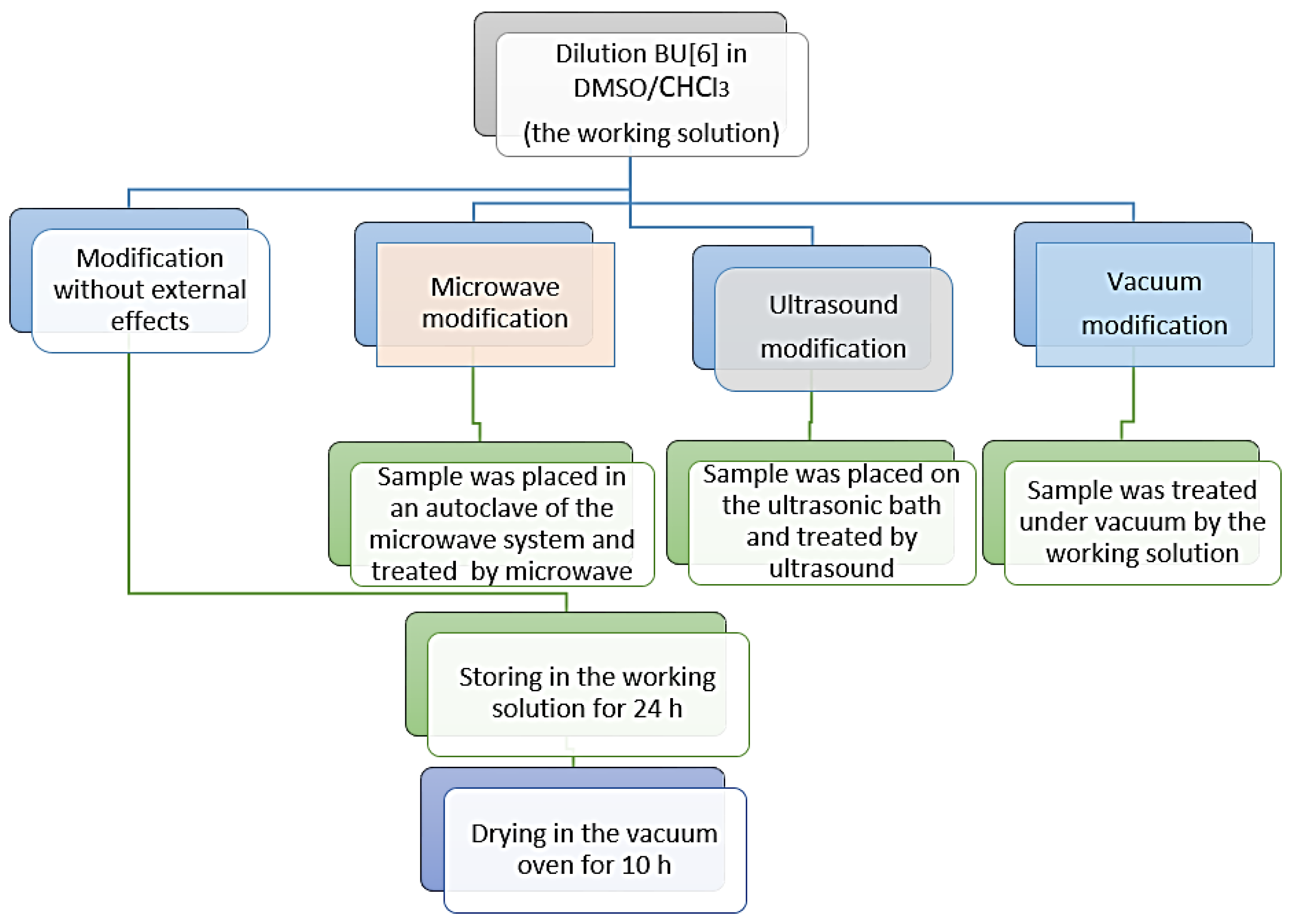
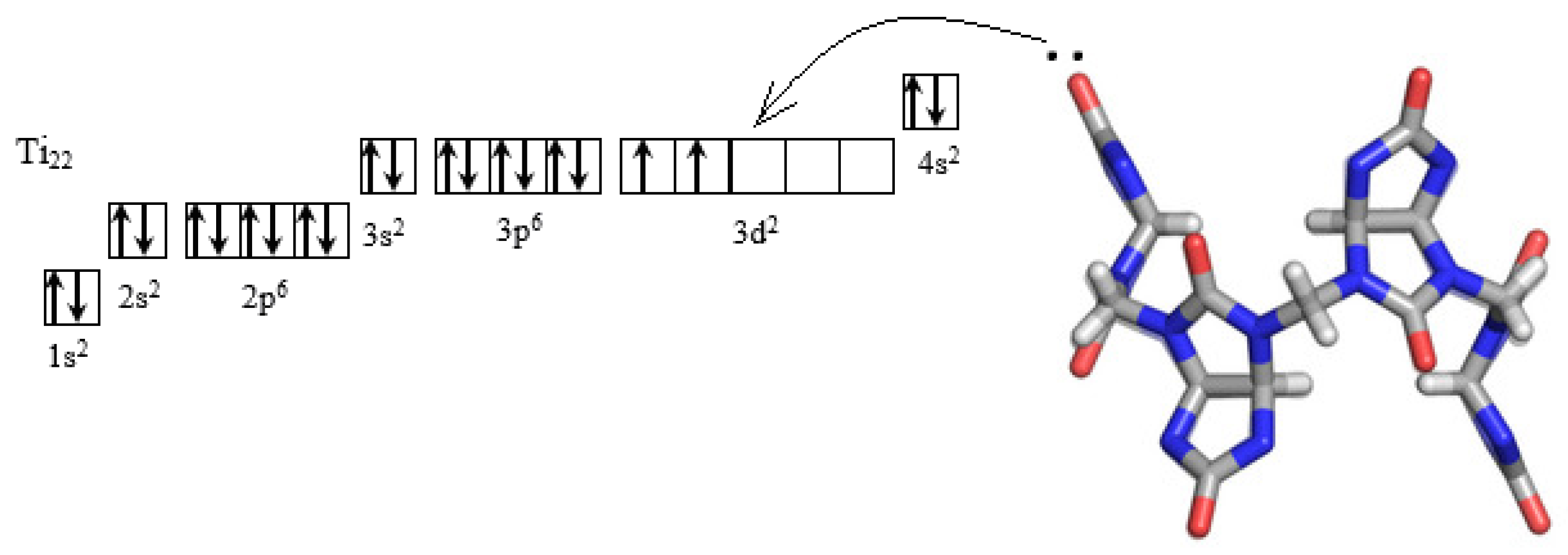


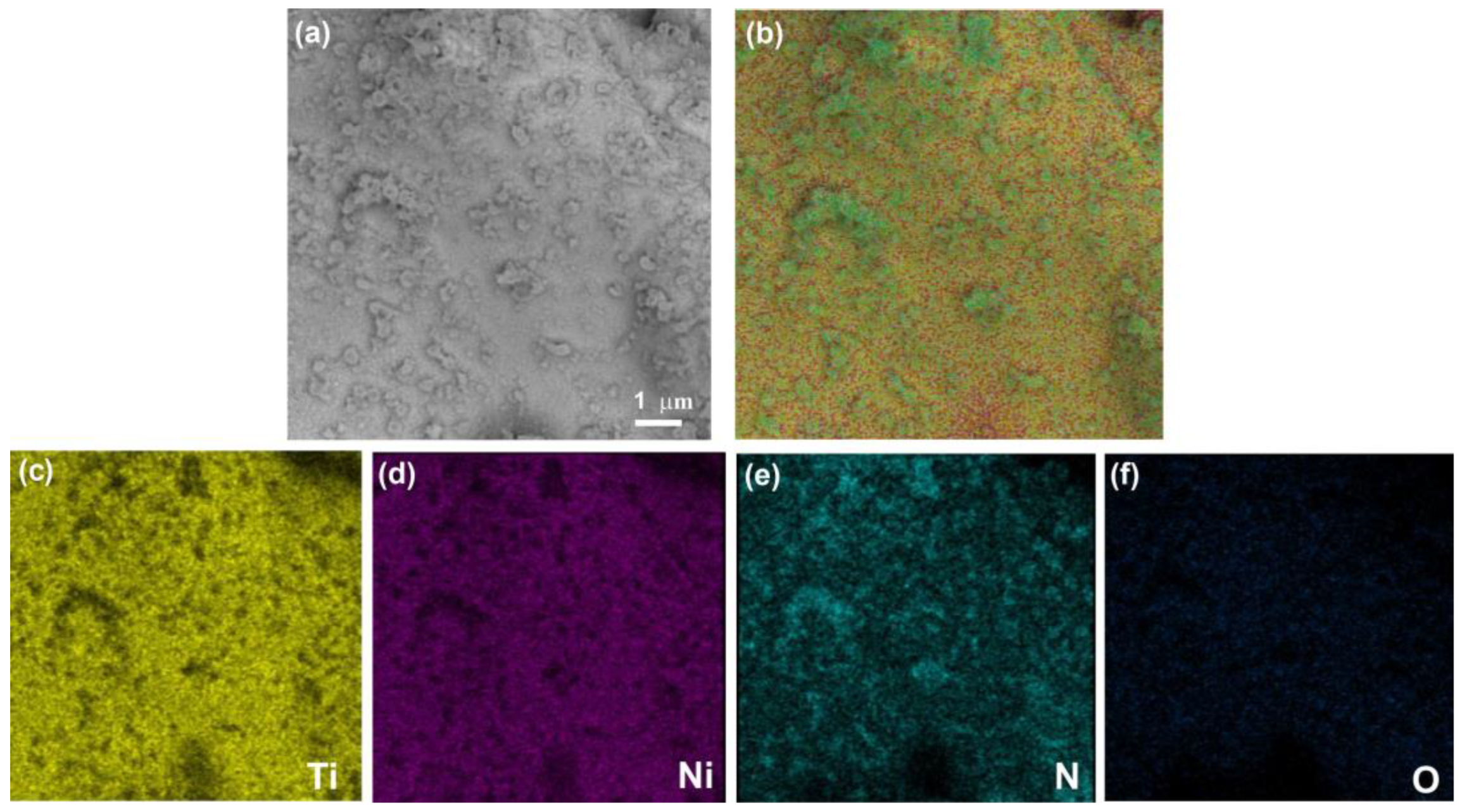
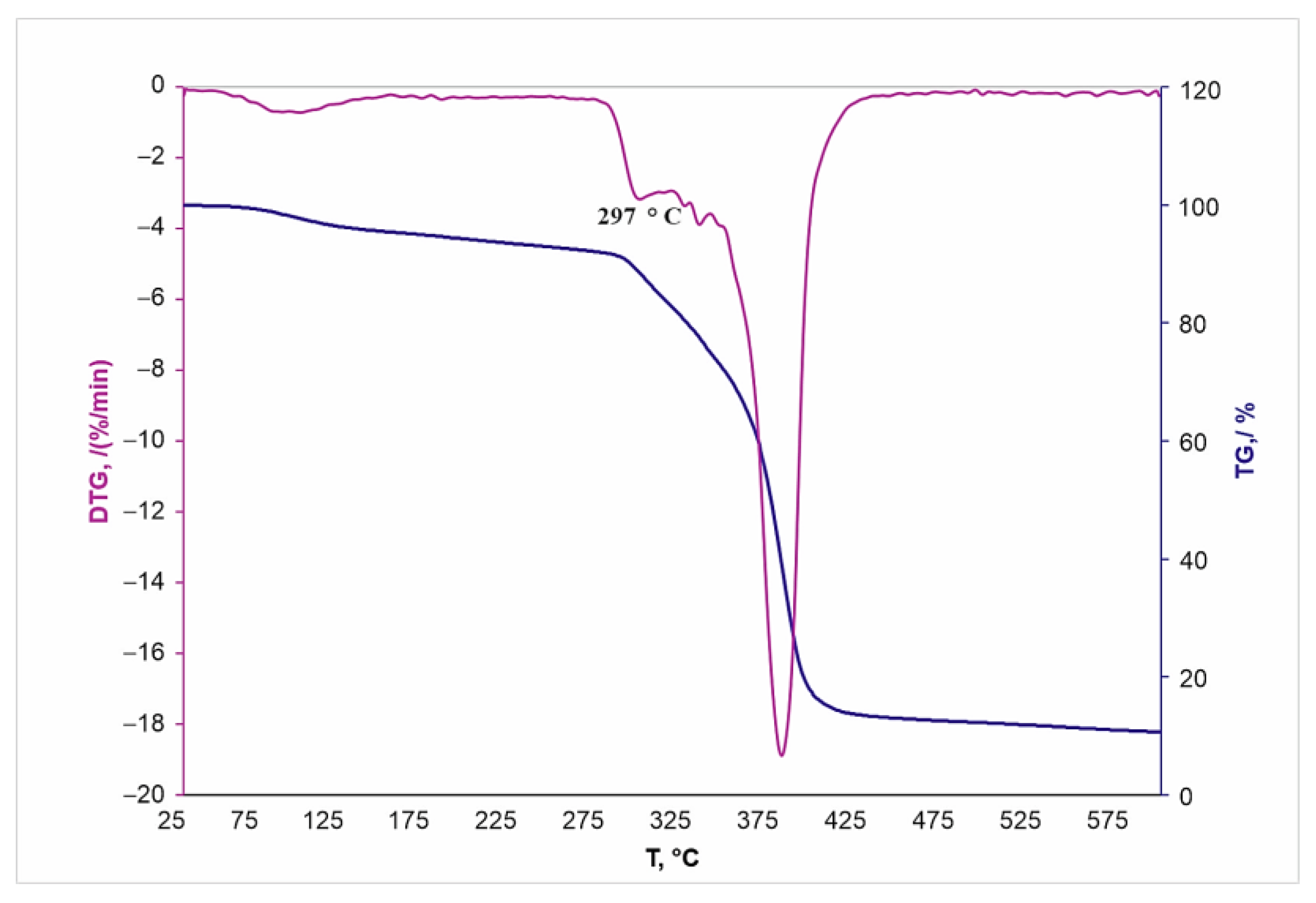
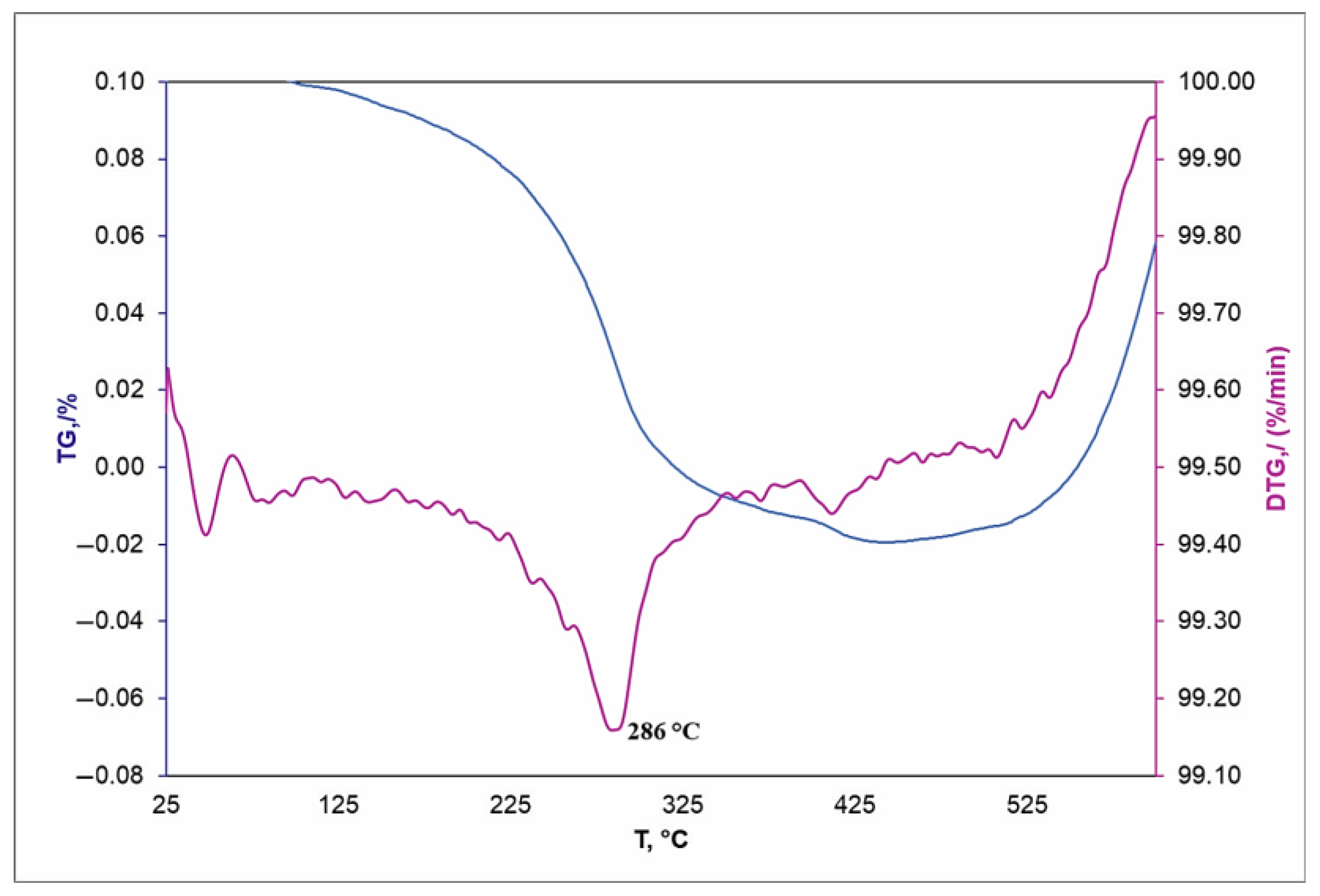


| Elements | Ti (±2) | Ni (±2) | N (±1) | O (±1) |
|---|---|---|---|---|
| wt.% | 42 | 34 | 9 | 15 |
| Modification Method | Control TiNi Sample | Under Vacuum | Without External Effects | Under Microwave Exposure | Under Ultrasonic Exposure |
|---|---|---|---|---|---|
| Hemolysis (%) | 0.6 | 0.3 | 6.5 | 1.4 | 1.6 |
Disclaimer/Publisher’s Note: The statements, opinions and data contained in all publications are solely those of the individual author(s) and contributor(s) and not of MDPI and/or the editor(s). MDPI and/or the editor(s) disclaim responsibility for any injury to people or property resulting from any ideas, methods, instructions or products referred to in the content. |
© 2022 by the authors. Licensee MDPI, Basel, Switzerland. This article is an open access article distributed under the terms and conditions of the Creative Commons Attribution (CC BY) license (https://creativecommons.org/licenses/by/4.0/).
Share and Cite
Marchenko, E.; Luchsheva, V.; Baigonakova, G.; Bakibaev, A.; Vorozhtsov, A. Functionalization of the Surface of Porous Nickel–Titanium Alloy with Macrocyclic Compounds. Materials 2023, 16, 66. https://doi.org/10.3390/ma16010066
Marchenko E, Luchsheva V, Baigonakova G, Bakibaev A, Vorozhtsov A. Functionalization of the Surface of Porous Nickel–Titanium Alloy with Macrocyclic Compounds. Materials. 2023; 16(1):66. https://doi.org/10.3390/ma16010066
Chicago/Turabian StyleMarchenko, Ekaterina, Venera Luchsheva, Gulsharat Baigonakova, Abdigali Bakibaev, and Alexander Vorozhtsov. 2023. "Functionalization of the Surface of Porous Nickel–Titanium Alloy with Macrocyclic Compounds" Materials 16, no. 1: 66. https://doi.org/10.3390/ma16010066
APA StyleMarchenko, E., Luchsheva, V., Baigonakova, G., Bakibaev, A., & Vorozhtsov, A. (2023). Functionalization of the Surface of Porous Nickel–Titanium Alloy with Macrocyclic Compounds. Materials, 16(1), 66. https://doi.org/10.3390/ma16010066






